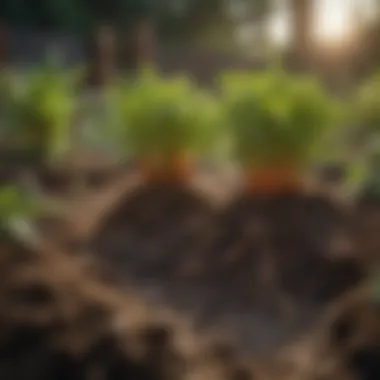Unlocking the Secrets to Perfect Soil in Your Raised Vegetable Garden


Gardening Methods for an Elevated Vegetable Garden
In the realm of enriching the soil for a raised vegetable garden, specific techniques and methods play a pivotal role in ensuring optimal growth conditions for your produce. By focusing on the composition of the soil, the incorporation of vital nutrients, and sustainable maintenance practices, you pave the way for a flourishing garden that yields abundant vegetables.
Soil Composition Strategies
The foundation of a successful raised vegetable garden lies in understanding and manipulating the composition of the soil. A harmonious blend of components such as loam, sand, and organic matter is fundamental for providing proper aeration, drainage, and nutrient retention. Striking the right balance between these elements forms the basis for healthy plant growth and robust vegetable production in your elevated garden bed.
Importance of Organic Matter
Organic matter acts as the lifeblood of your garden soil, nurturing beneficial microbes and fostering a thriving ecosystem underground. Incorporating compost, well-rotted manure, or leaf mold enriches the soil with essential nutrients, improves its structure, and enhances water retention capacity, creating a fertile environment conducive to vegetable cultivation.
Nutrient Enrichment Techniques
Supplementing the soil with vital nutrients is a critical step in optimizing its quality for a raised vegetable garden. Utilizing natural amendments like bone meal, blood meal, and various organic fertilizers helps replenish essential elements that foster plant growth and fruit development. Adopting a comprehensive approach to nutrient enrichment ensures that your vegetables receive a well-rounded diet for sustained health and productivity.
Effective Mulching Practices
Mulching serves as a multifaceted tool in maintaining soil fertility and moisture levels in your elevated garden bed. Applying a layer of organic mulch, such as straw, shredded leaves, or grass clippings, not only conserves water and suppresses weeds but also enriches the soil as it decomposes, releasing nutrients gradually to support the growth of your vegetable plants.
Sustainable Maintenance Methods
To sustain the vigor and productivity of your raised vegetable garden's soil, implementing regular maintenance practices is paramount. Conducting soil tests periodically to assess nutrient levels, p H balance, and overall soil health empowers you to fine-tune your enrichment strategies for optimal plant nutrition. Additionally, cultivating cover crops during off-seasons and practicing crop rotation help mitigate soil depletion, combat pests and diseases, and uphold the long-term fertility of your garden bed.
Understanding Soil Composition


In this article, delving into the crucial topic of Understanding Soil Composition is paramount for anyone seeking to optimize soil for a raised vegetable garden. By dissecting the Components of Ideal Garden Soil, including Organic Matter, Mineral Particles, and Microorganisms, we lay the foundation for a successful gardening journey. Organic Matter, being a pivotal element, contributes rich nutrients essential for plant growth. Its decomposition enhances soil structure and fertility, making it a popular choice for garden enrichment. Mineral Particles, on the other hand, provide stability to the soil and aid in nutrient retention. Despite potential drawbacks like compaction, they remain indispensable for cultivating healthy vegetation. Moreover, Microorganisms play a vital role in soil health by breaking down organic matter, releasing nutrients, and fostering symbiotic relationships with plants. Understanding these components empowers gardeners to create a conducive environment for robust plant growth.
Components of Ideal Garden Soil
Organic Matter
Organic Matter serves as the lifeblood of garden soil, offering a plethora of benefits essential for plant development. Its organic content enriches the soil with vital nutrients, fostering a nutrient-rich environment conducive to plant growth. The key characteristic of Organic Matter lies in its ability to enhance soil fertility naturally, making it a sustainable and environmentally friendly choice for gardening. Despite its numerous advantages, gardeners must be mindful of the decomposition process, which may produce an earthy aroma but is crucial for nutrient release and soil enrichment.
Mineral Particles
Mineral Particles, such as sand, silt, and clay, contribute significantly to soil structure and nutrient retention. Their key characteristic lies in regulating water infiltration and drainage, crucial for healthy root development. While they offer essential minerals to plants, improper ratios can lead to issues like poor aeration or drainage. Understanding the unique feature of Mineral Particles aids in balanced soil composition, promoting optimal plant growth while mitigating potential challenges like compaction.
Microorganisms
Microorganisms, including bacteria and fungi, play a crucial role in soil health and plant development. Their key characteristic lies in decomposing organic matter, releasing nutrients that are vital for plant uptake. While beneficial in fostering symbiotic relationships with plants, some microorganisms can cause diseases if not managed effectively. Recognizing the unique feature of Microorganisms empowers gardeners to create a balanced microbial ecosystem in their soil, promoting plant health and resilience.
Impact of Soil p
H on Plant Growth
Delving into the Impact of Soil p H on Plant Growth sheds light on how acidity or alkalinity influences plant health in a raised vegetable garden. Contrasting Acidic vs. Alkaline Soil reveals the significance of pH levels in nutrient availability and plant absorption. Acidic soils, characterized by lower pH levels, offer certain benefits like increased iron availability but may hinder nutrient uptake. On the other hand, Alkaline soils, with higher pH levels, provide optimal conditions for certain plants while restricting others. Choosing the Right pH Level becomes crucial in balancing soil acidity for specific plant requirements, ensuring optimal growth and yield. Understanding these aspects empowers gardeners to fine-tune their soil pH, creating an ideal environment for robust plant development.
Enhancing Soil Fertility
In the realm of gardening, the foundation of success lies in the fertility of the soil. The section on enhancing soil fertility delves into the pivotal role played by nutrient-rich soil in supporting the healthy growth and proliferation of vegetables in a raised garden. It emphasizes the significance of fortifying the soil with essential elements to create an optimal environment conducive to robust plant development. By focusing on enhancing soil fertility, gardeners can ensure that their plants receive the necessary nourishment to thrive and produce abundant yields.
Adding Organic Amendments


Compost
Compost stands out as a cornerstone in the realm of organic amendments for soil enrichment. Its significance stems from its ability to supplement the soil with a rich array of nutrients that foster plant vitality. Compost, derived from organic materials undergoing decomposition, infuses the soil with a diverse blend of organic matter essential for plant growth. The distinctive feature of compost lies in its capacity to improve soil structure, enhance moisture retention, and promote beneficial microbial activity. Despite its numerous advantages, gardeners need to be cautious about balancing the compost application to prevent nutrient imbalances that may negatively impact plant health.
Manure
Manure is another vital component in the realm of organic soil amendments. Its contribution to soil fertility lies in its high nutrient content, making it a popular choice for enriching garden soil. Rich in organic matter and various essential nutrients, manure aids in cultivating fertile soil that supports vigorous plant growth. Gardeners appreciate manure for its ability to enhance soil fertility efficiently. However, it is crucial to ensure proper composting and application to mitigate the risk of over-fertilization and potential plant damage.
Cover Crops
Introducing cover crops to the garden serves as a strategic approach to enhancing soil fertility. Cover crops play a dual role by safeguarding the soil against erosion and enriching it with organic matter when turned into the soil. The key characteristic of cover crops lies in their ability to fix nitrogen, suppress weeds, and improve soil structure while maintaining moisture levels. Choosing suitable cover crops tailored to the specific needs of the garden ecosystem can significantly contribute to fostering a healthy soil environment. Despite their benefits, the integration of cover crops necessitates thoughtful planning and consideration to maximize their advantages while avoiding potential drawbacks.
Utilizing Inorganic Fertilizers
Nitrogen, Phosphorus, Potassium
The trio of essential nutrients - nitrogen, phosphorus, and potassium, are integral components of inorganic fertilizers critical for promoting plant growth. Nitrogen aids in leafy green growth, phosphorus supports root development, and potassium enhances overall plant health and resilience. Their key characteristic lies in their targeted action on specific aspects of plant physiology, ensuring balanced nutrition for optimal growth and productivity. Incorporating these essential nutrients through inorganic fertilizers can address soil deficiencies and enhance plant vigor. However, judicious application and monitoring are necessary to prevent nutrient imbalances that may have detrimental effects on plant health.
Balancing Nutrient Levels
Maintaining the delicate balance of nutrient levels in the soil is imperative for sustaining a healthy and productive garden ecosystem. Balancing nutrient levels involves harmonizing the concentrations of key elements such as nitrogen, phosphorus, and potassium to prevent deficiencies or excesses that hinder plant development. The key characteristic of this practice is its role in fostering optimal nutrient uptake by plants, supporting robust growth and vitality. By maintaining balanced nutrient levels, gardeners can ensure the continued health and productivity of their raised vegetable garden. However, diligent monitoring and precise application of fertilizers are essential to prevent nutrient imbalances that may compromise the overall well-being of the garden.
Managing Soil Structure
In the realm of gardening, managing soil structure holds paramount importance as it directly influences the success of your raised vegetable garden. The structure of soil impacts crucial factors like water drainage, aeration, and root development, all of which are essential for thriving plants. By focusing on managing soil structure, you are not only ensuring optimal conditions for plant growth but also promoting long-term soil health and sustainability. It is imperative to pay attention to the composition and texture of your soil to create a conducive environment for your vegetable garden to flourish.


Aeration and Drainage
Importance of Air Circulation:
The significance of air circulation in soil cannot be overstated when aiming for a successful vegetable garden. Adequate air circulation within the soil helps in oxygenating the roots, facilitating nutrient uptake, and promoting beneficial soil microorganisms' growth. This process aids in preventing root diseases and fostering robust plant growth. Air circulation also plays a vital role in maintaining optimal soil moisture levels, creating a harmonious environment for plant roots to prosper.
Preventing Waterlogging:
Preventing waterlogging is another crucial aspect of managing soil structure to ensure the well-being of your plants. Excess water can lead to oxygen deprivation in the soil, hampering root growth and nutrient absorption. By implementing strategies to prevent waterlogging, such as proper drainage systems and soil amendments, you can avert potential water-induced issues and safeguard your vegetables from drowning stress. Maintaining balanced soil moisture levels is key to preventing waterlogging and enhancing the overall health of your raised garden beds.
Avoiding Soil Compaction
Proper Tilling Techniques:
Adopting proper tilling techniques is essential in avoiding soil compaction and promoting healthy root development. Tilling helps loosen compacted soil, allowing for better penetration of water, air, and nutrients. It also assists in breaking up clumps and creating a favourable environment for roots to establish and spread. However, excessive tilling can disrupt the soil structure, so it is crucial to strike a balance and practice gentle tilling methods to maintain soil integrity while improving aeration and nutrient availability.
Using Raised Beds:
Utilizing raised beds is a practical solution to circumvent soil compaction issues and provide optimal growing conditions for your vegetables. Raised beds elevate the planting area, reducing the risk of soil compaction from foot traffic and heavy machinery. They offer better drainage, improved aeration, and easier maintenance compared to traditional in-ground gardens. Additionally, raised beds allow for customized soil mixes, enhancing fertility and boosting plant growth. Incorporating raised beds into your gardening approach can significantly enhance your soil structure and overall garden productivity.
Implementing Sustainable Practices
Whether you are a novice or a seasoned gardener, implementing sustainable practices in your raised vegetable garden is crucial for long-term success. Sustainable practices not only benefit the environment but also enhance the overall health and productivity of your garden. By incorporating mulching and companion planting techniques, you can create a self-sustaining ecosystem that promotes biodiversity and improves soil quality over time.
Mulching and Companion Planting
Benefits of Mulching
Mulching is a fundamental aspect of sustainable gardening practices that offers a myriad of benefits. By covering the soil with a layer of organic material such as straw, leaves, or grass clippings, mulching helps retain moisture, suppress weeds, regulate soil temperature, and promote microbial activity. The key characteristic of mulching lies in its ability to conserve water by reducing evaporation, thereby ensuring that your plants receive adequate hydration throughout the growing season. This practice is a popular choice for raised vegetable gardens as it aids in drought resistance, minimizes erosion, and adds nutrients to the soil as the mulch decomposes. Despite its advantages, proper mulching requires attention to detail to prevent issues like fungal diseases or rodent infestations.
Complementary Plant Pairings
Companion planting, another sustainable gardening practice, involves growing compatible species together to maximize space utilization and enhance growth. Complementary plant pairings are strategically planned to create mutually beneficial relationships among plants, such as repelling pests, attracting beneficial insects, or improving soil fertility. The key characteristic of companion planting is its ability to mimic natural ecosystems, where plants support each other's growth and provide a balanced microclimate. This approach is favored for its organic pest control benefits, increased pollination efficiency, and a more aesthetically pleasing garden layout. However, careful consideration of plant compatibility and growth habits is essential to avoid competition for resources and ensure optimal results in your raised vegetable garden.







